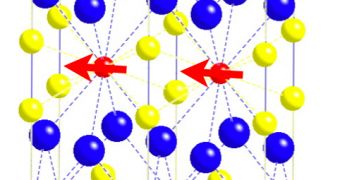Common sense tells us that glassy materials, just like typical glass, should form disordered crystalline structures resembling the state of frozen liquids as frustration prevents the atoms from freezing into a well ordered state. However, in spin glasses the disordered crystalline structure is induced by the magnetic moments of the atoms, as opposed to the atoms themselves as in the case of regular glass, allowing them to freeze into random directions when the material is brought to low temperatures.
Nevertheless, investigations have showed that some disorder must be present in the atomic structure as well as frustration in the magnetic field interactions in order to prevent the magnetic moments of the atoms from creating an ordered structure, to form a spin glass. But in PrAu2Si2 there is no evidence of atomic disorder or magnetic interaction frustrations, yet the compound is a spin glass.
"This has been a puzzle for 10 years now," said physicist Raymond Osborn of the U.S. Department of Energy's Argonne National Laboratory, part of the research team that recently revealed the processes through which certain spin glasses form. Investigations carried out with the help of a neutron scattering technique showed that in spin glasses there is no static frustration, but rather temporal or dynamic frustration.
At first sight, PrAu2Si2 appears to have an ordered crystalline structure, but the Argonne team proved that in fact the magnetic moments of the atoms are continuously fluctuating, thus creating temporal disruption in the surface which in turn affects the magnetic alignment of the atoms. Osborn said that this is the result of instability in the magnetic moments, and that the fluctuations can be temporarily stabilized by electrons bouncing off the surface of the atoms.
"The discovery of dynamic frustration reveals a whole new class of glassy materials whose behavior is governed by dynamic rather than static disorder," Osborn said.

 14 DAY TRIAL //
14 DAY TRIAL //